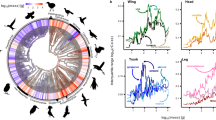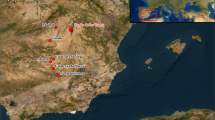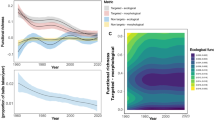Abstract
Classical models of foraging behaviour1–3 assume that feeding patterns maximising the net caloric gain per unit time or minimising the tune spent in foraging will be favoured by natural selection. There is some evidence for this behaviour in some foragers4, mostly higher vertebrates for which time and energy constraints are frequently paramount. However, while these models may suffice under some circumstances, nutritional information from the veterinary, wildlife management, and entomological literature shows that an animal requires a diet containing all necessary nutrients to be truly fit (physiologically and evolutionarily). Therefore unless animals are very severely constrained energetically, foraging behaviour should lead to nutritional as well as caloric optimisation. Here I show that free-living wolf spiders will tend to prey on three species in proportions which optimise the proportions of the essential amino acids they provide in the diet.
This is a preview of subscription content, access via your institution
Access options
Similar content being viewed by others
References
Emlen, J. M. Am. Nat. 100, 611–617 (1966).
MacArthur, R. H. & Pianka, E. R. Am. Nat. 100, 603–609 (1966).
Schoener, T. W. A. Rev. ecol. Syst. 2, 369–404 (1971).
Pyke, G. H., Pulliam, H. R. & Charnov, E. L. Q. Rev. Biol. 52, 137–154 (1977).
Greenstone, M. H. thesis, Univ. Calif. Berkeley (1976).
Greenstone, M. H. J. appl. Ecol. 14, 457–464 (1977).
Freeland, W. J. & Janzen, D. H. Am. Nat. 108, 269–289 (1974).
Sokal, R. R. & Rohlf, F. J. Biometry, 589 (Freeman, San Francisco, 1969).
House, H. L. A. Rev. Biochem. 31, 653–672 (1962).
Dadd, R. H. A. Rev. Ent. 18, 381–420 (1973).
Baker, I. & Baker, H. G. New Phytol. 76, 87–98 (1976).
Nakamura, M. & Nakamura, K. Oecologia 27, 97–116 (1977).
Hardman, J. M. thesis, Simon Fraser Univ. (1972).
Custer, T. W. & Pitelka, F. A. Condor 77, 210–212 (1975).
Campbell, H. G. Matrices with Applications, 14 (Appleton-Century Crofts, New York, 1968).
Fuentes, E. R. Ecology 57, 3–17 (1976).
Siegel, S. Non-parametric Statistics for the Behavioral Sciences, 116–127 (McGraw-Hill, New York, 1956).
Barnett, S. A. The Rat 61 (University of Chicago Press, 1975).
Holling, C. S. Mem. ent. Soc. Canada 45, 1–60 (1965).
Waldbauer, G. P. & Bhattacharya, A. K. J. Insect. Physiol. 19, 407–418 (1973).
Tinbergen, L. Archs neerl. Zool. 13, 266–379 (1960).
Edgar, W. D. J. Zool. Lond. 159, 405–411 (1969); Neth J. Zool. 20, 487–491 (1970).
Hallander, H. Oikos 21, 337–340 (1970).
Yeargan, K. V. Env. Ent. 4, 137–141 (1975).
Miyashita, K. Appl. Ent. Zool. 3, 81–88 (1968).
Hydhorn, S.B. thesis, Univ. Calif. Berkeley(1977).
Slanksky, F., Jr. & Feeney, P. Ecol. Monogr. 47, 209–228 (1977).
White, T.C.R. Oecologia 33, 71–86 (1978).
Stenseth, N. C. & Hansson, L. Am. Nat. 113, 373–389 (1979).
Marten, G. G. Ecology 54, 92–101 (1973).
Pulliam, H. R. Am. Nat. 109, 765–768 (1975).
Westoby, M. Am. Nat. 108, 290–304 (1974).
Author information
Authors and Affiliations
Rights and permissions
About this article
Cite this article
Greenstone, M. Spider feeding behaviour optimises dietary essential amino acid composition. Nature 282, 501–503 (1979). https://doi.org/10.1038/282501a0
Received:
Accepted:
Published:
Issue Date:
DOI: https://doi.org/10.1038/282501a0
This article is cited by
-
Lethal and sublethal effects of five common herbicides on the wolf spider, Pardosa milvina (Araneae: Lycosidae)
Ecotoxicology (2022)
-
Emerging mosquitoes (Aedes nigripes) as a resource subsidy for wolf spiders (Pardosa glacialis) in western Greenland
Polar Biology (2021)
-
The spinning apparatus of webspinners – functional-morphology, morphometrics and spinning behaviour
Scientific Reports (2015)
-
Predator hunting mode influences patterns of prey use from grazing and epigeic food webs
Oecologia (2013)
-
10.1007/BF00361311
CrossRef Listing of Deleted DOIs (2011)
Comments
By submitting a comment you agree to abide by our Terms and Community Guidelines. If you find something abusive or that does not comply with our terms or guidelines please flag it as inappropriate.



